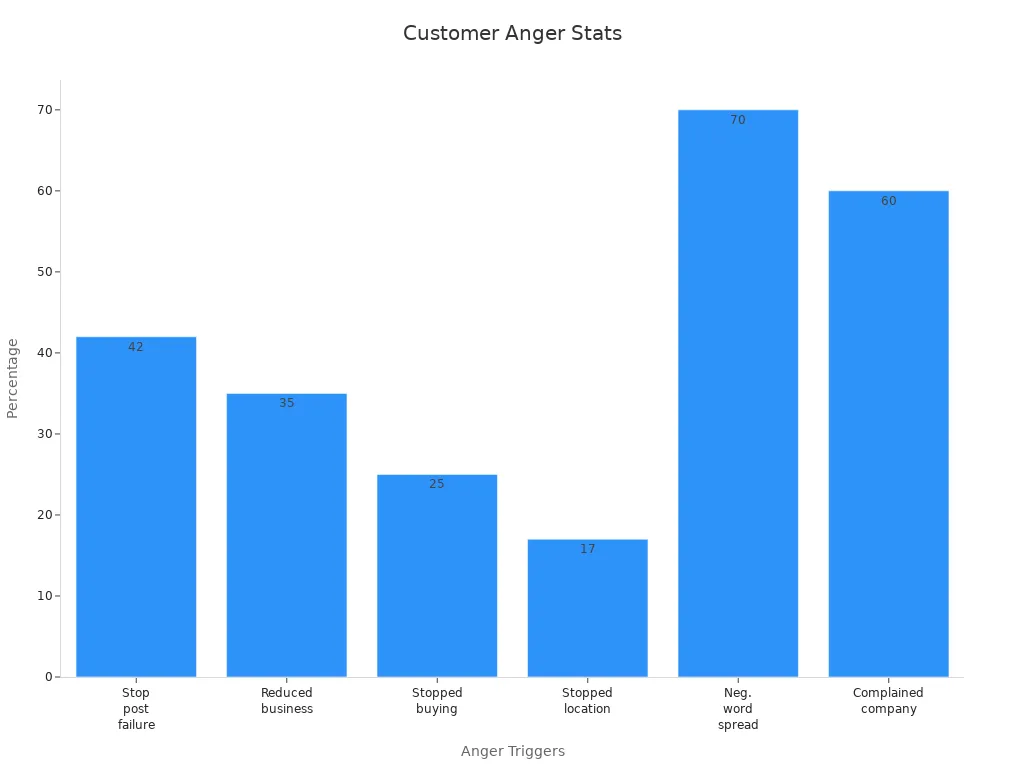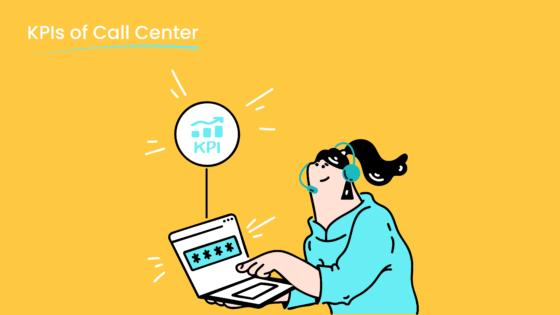Mastering the Art of Calming Angry Customers

Dealing with angry customers is no walk in the park, but mastering this skill can transform your customer service game. Did you know that 96% of unhappy customers don’t complain, yet 91% of them will leave and never come back? Addressing their concerns quickly and with empathy can make all the difference. Simple actions like listening and responding thoughtfully can boost satisfaction and loyalty. So, how would you handle an upset customer? By staying calm and showing you care, you can turn frustration into trust and even strengthen your business reputation. Tools like Sobot’s solutions can help you do just that.
Why Customers Get Angry
Understanding why customers get angry is the first step in turning a negative interaction into a positive experience. Let’s explore the common triggers, the role of expectations, and how miscommunication can make things worse.
Common Triggers of Customer Frustration
Customers often feel frustrated when their needs aren’t met. Some common triggers include long wait times, unhelpful staff, or poor product quality. Imagine waiting on hold for 30 minutes only to be transferred to the wrong department—frustrating, right?
Here’s a quick look at how these frustrations impact businesses:
| Statistic | Description |
|---|---|
| 42% | Customers who stopped doing business after a service failure |
| 70% | Customers who spread negative word-of-mouth |

When you acknowledge the problem and respond with empathy, you can prevent these outcomes and create a more positive experience.
The Role of Expectations in Customer Anger
Unmet expectations are a major source of customer anger. When customers expect quick resolutions or high-quality service and don’t get it, frustration builds. For example, a study found that customer aggression negatively impacts employee performance, especially when job stress is high. This shows how important it is to stay calm and manage expectations effectively.
You can reduce anger by setting clear expectations upfront. If a delay is unavoidable, let the customer know immediately. Transparency helps build trust and improves customer retention.
How Miscommunication Escalates Issues
Miscommunication can turn a small issue into a big problem. For instance, outdated systems or fragmented communication channels often lead to confusion. One organization reported a 25% drop in customer satisfaction due to these issues. Over two-thirds of employees also said communication problems waste time and hurt productivity.

To avoid this, ensure your team communicates clearly and consistently. Tools like Sobot’s omnichannel solutions can help streamline communication, making it easier to handle an upset customer and deliver a positive experience.
The Importance of Handling Angry Customers
Impact on Customer Loyalty and Retention
Handling angry customers effectively isn’t just about resolving a single issue—it’s about building trust that keeps them coming back. When you address complaints with active empathy, you show customers that their concerns matter. This can turn a negative experience into a positive one, boosting loyalty. On the flip side, mishandling complaints can lead to refunds, bad reviews, or even lost customers.
Here’s why this matters:
- Properly managing complaints enhances satisfaction and loyalty.
- Ignoring or mishandling issues risks losing customers and damaging your reputation.
- Resolving problems with care can transform frustrated customers into brand advocates.
By focusing on active empathy and quick resolutions, you can create lasting relationships that benefit your business.
How It Affects Business Reputation
Your reputation is on the line every time you interact with an upset customer. When you resolve conflicts efficiently, customers are more likely to forgive mistakes and continue doing business with you. In fact, a study found that customers whose complaints are resolved in under five minutes are willing to spend more in the future.
Here’s how effective conflict resolution helps:
- It shows professionalism and care, which protects your reputation.
- Customers who feel heard are more likely to recommend your brand.
- Swift resolutions can turn unhappy customers into loyal advocates.
By showing empathy and addressing issues promptly, you not only retain customers but also enhance your brand’s image.
The Financial Implications of Poor Customer Service
Poor customer service can cost you more than just a few unhappy customers. It can lead to significant financial losses. For example:
| Statistic | Implication |
|---|---|
| 49% of customers who left a brand cite poor customer experience (CX) | Indicates a significant loss of loyal customers due to inadequate service. |
| 1 in 3 customers will leave after one bad experience | Highlights the immediate risk of losing customers after a single negative interaction. |
| 92% would abandon a company after 2-3 negative interactions | Emphasizes the cumulative effect of poor service on customer retention. |
| Customers are 4 times more likely to defect due to service issues | Suggests that service-related problems are a major driver of customer churn compared to price. |
| 96% of unhappy customers don’t complain, but 91% will leave | Points to the hidden risk of customer loss due to unvoiced dissatisfaction. |
By prioritizing customer service and practicing active empathy, you can avoid these costly outcomes. Happy customers are more likely to stay, spend more, and recommend your business to others.
Key Strategies for Handling Angry Customers

How to Respond with Empathy
Empathy is your secret weapon when dealing with upset customers. By putting yourself in their shoes, you show that you genuinely care about their concerns. Research shows that even a 1% increase in empathy can boost customer gratitude by up to 90%. That’s a huge impact! When you respond sincerely, customers feel valued, which helps calm their frustration. Use phrases like, “I understand how this could be upsetting,” to convey a calm tone of voice and build trust.
Active Listening Techniques
Active listening is more than just hearing words—it’s about understanding the message behind them. Here’s how it helps improve the customer experience:
- It ensures you fully grasp the customer’s concerns.
- It reduces misunderstandings and confusion.
- It helps you identify pain points and provide a solution quickly.
To practice active listening, maintain eye contact, nod occasionally, and summarize what the customer says. These small actions make a big difference.
Staying Calm and Professional
Staying calm is crucial when emotions run high. People with strong emotional intelligence can de-escalate tense situations by keeping their cool. Avoid reacting defensively or raising your voice. Instead, use a calm tone of voice to reassure the customer. This approach fosters effective communication and prevents conflicts from escalating.
Apologizing Sincerely and Effectively
A genuine apology can turn a bad situation around. Acknowledge the issue and take responsibility. For example:
| Action | Outcome |
|---|---|
| Apologizing sincerely | Customers feel respected and valued. |
| Communicating with empathy | Builds loyalty and turns negative experiences into positive ones. |
| Resolving issues effectively | Enhances customer satisfaction and retention. |
When you apologize, focus on making the customer feel heard and appreciated.
How to Provide a Solution That Works
A solution-oriented mindset is key to resolving issues. Customers value quick and effective resolutions. Metrics like CSAT and NPS show that satisfaction increases when problems are solved efficiently. Remember, 66% of customers prioritize experience over cost. So, focus on delivering a solution that meets their needs while enhancing their overall customer experience.
Following Up to Ensure Customer Satisfaction
Following up shows customers that their opinions matter. Ask for feedback and let them know how their input has led to improvements. This not only closes the feedback loop but also reinforces their trust in your brand. By taking this extra step, you create a lasting positive impression.
Common Mistakes to Avoid When Dealing with Difficult Customers

Taking Customer Anger Personally
It’s easy to feel attacked when a customer is upset, but taking their anger personally can make things worse. Remember, their frustration is usually about the situation, not you. Reacting emotionally might escalate the issue instead of resolving it. Instead, focus on staying calm and professional. This helps you maintain control and keeps the conversation productive. Think of yourself as a problem-solver, not the target of their frustration. By keeping your emotions in check, you can turn a heated moment into an opportunity to build trust.
Interrupting or Talking Over the Customer
When a customer is venting, interrupting them can feel dismissive. It sends the message that you’re not interested in what they have to say. This can make them even angrier. Instead, let them speak without cutting them off. Use active listening techniques like nodding or summarizing their concerns to show you’re paying attention. For example, saying, “I understand you’re upset about the delay,” can help them feel heard. Listening fully not only calms the customer but also gives you the information you need to resolve the issue effectively.
Making False Promises
Making promises you can’t keep might seem like a quick fix, but it often backfires. Broken promises damage trust and can lead to serious consequences. Here’s a closer look:
| Consequence | Description |
|---|---|
| Financial penalties | Companies face significant financial penalties for failing to deliver on promises. |
| Reputational damage | Broken promises can lead to lasting damage to a company's reputation. |
| Reduced trust from shareholders | Trust issues extend beyond customers to shareholders, affecting overall company perception. |
| Regulatory actions | Regulators like ACCC and ASIC have taken action against companies for failing to meet customer promises. |
To avoid these pitfalls, always be honest about what you can deliver. Managing expectations is key to maintaining trust when dealing with difficult customers.

Failing to Document the Interaction
Failing to document customer interactions can cause problems down the line. Without proper records, you might miss important details or repeat mistakes. Documentation helps you track the issue, follow up, and ensure the customer feels valued. Tools like Sobot’s Voice/Call Center make this process seamless by providing features like call tracking and recording. These tools not only improve efficiency but also help you deliver better service. Keeping accurate records shows customers that you’re committed to resolving their concerns.
Building Long-Term Skills for Handling Angry Customers
Training in Emotional Intelligence
Emotional intelligence (EI) is a game-changer when it comes to handling difficult customers. It helps you stay calm, understand emotions, and respond with empathy. Training in EI equips you to navigate heated customer conversations with confidence. Did you know that 90% of top-performing employees have high EI, compared to just 20% with high IQ? This skill doesn’t just improve customer interactions—it also boosts team productivity and leadership.
Organizations that prioritize EI training often see higher satisfaction scores from clients. Here’s a quick breakdown of its benefits:
| Evidence Type | Description |
|---|---|
| Satisfaction Scores | Companies focusing on EI training achieve better client satisfaction. |
| Top Performers | 90% of top employees excel in EI, showing its importance in customer care. |
| Leadership Impact | EI training enhances team productivity and leadership effectiveness. |
By investing in EI training, you’re not just building trust with customers—you’re also creating a more effective team.
Role-Playing and Scenario Practice
Role-playing is one of the best ways to sharpen your customer service skills. It allows you to practice handling difficult customers in a safe environment. You can make mistakes, learn from them, and improve. This method builds confidence and enhances your ability to manage real-life customer conversations.
Here’s why role-playing works so well:
- It helps you understand customer perspectives and emotions.
- It improves time-to-resolution by preparing you for various scenarios.
- It boosts communication skills, like active listening and empathetic responses.
- It accelerates learning for new team members.
For example, practicing how to de-escalate an angry caller can make you more effective during actual interactions. Tools like Sobot’s Voice/Call Center can support this by providing call recordings and analytics for review, helping you refine your approach.
Seeking Feedback and Continuous Improvement
Feedback is your secret weapon for improving customer service skills. Whether it’s from customers, peers, or supervisors, feedback highlights areas where you can grow. For instance, a major retail chain used Net Promoter Score (NPS) feedback to address customer pain points, which increased their market share.
Here’s how you can use feedback effectively:
- Monitor key metrics like Average Handle Time (AHT) and Customer Satisfaction Score (CSAT).
- Use customer surveys to uncover hidden issues.
- Review call recordings to identify patterns and improve responses.
Sobot’s Voice/Call Center makes this process seamless. It tracks metrics like first-call resolution rates and provides insights to help you deliver better service. By focusing on continuous improvement, you can turn every interaction into a learning opportunity.

Leveraging Sobot's Voice/Call Center for Better Customer Interactions
Sobot’s Voice/Call Center is a powerful tool for managing difficult customers. It offers features like smart call routing, real-time monitoring, and AI-powered voicebots. These tools help you handle customer conversations more efficiently and with empathy.
Here’s how it can improve your interactions:
| Metric | Description |
|---|---|
| Average Handling Time | Reduces call duration, making issue resolution faster. |
| First Call Resolution Rate | Ensures problems are solved on the first call, boosting satisfaction. |
| Customer Satisfaction Score | Tracks happiness levels, helping you measure service quality. |
For example, a cosmetics e-commerce company used Sobot’s system to optimize their call center operations. This led to happier customers and lower service costs. By leveraging advanced tools like these, you can transform how you handle difficult customers and build lasting trust.
Mastering the art of calming angry customers starts with empathy, professionalism, and clear communication. These strategies not only resolve conflicts but also build trust and loyalty. Did you know 83% of consumers value great service for brand loyalty? By applying these tips, you’ll create positive experiences that keep customers coming back.
Quick Stats:
- 89% of customers return after a positive experience.
- 93% make repeat purchases with brands offering excellent service.
FAQ
How can you calm an angry customer quickly?
Start by listening actively. Show empathy and acknowledge their frustration. Offer a solution that addresses their concerns. Follow up to ensure satisfaction.
What tools help manage angry customer interactions?
Sobot’s Voice/Call Center simplifies communication. It tracks calls, routes them smartly, and provides real-time insights. These features improve efficiency and customer satisfaction.
Why is empathy important when dealing with an angry customer?
Empathy builds trust. It shows you care about their feelings and concerns. This approach helps de-escalate situations and creates a positive experience.
See Also
Enhancing Customer Support Through Effective Live Chat Strategies
Ten Strategies to Improve Customer Satisfaction via Live Chat
Effective Strategies for Managing Live Chat Support Agents